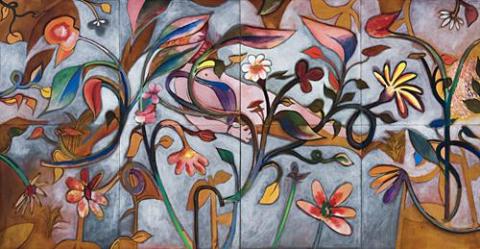THE ROCK POOL, 1973
Charles Blackman
oil on canvas (diptych in 8 panels)
192.0 x 366.0 cm (overall)
signed and dated upper right: BLACKMAN / 73
Philip Bacon Galleries, Brisbane
Private collection, Queensland
Charles Blackman, Fuji Television Gallery, Tokyo, September 1973
Amadio, N., Charles Blackman: The Lost Domains, A.H. & A.W. Reed Pty. Ltd., Sydney, 1980, pp. 100–101, 105, pl. 6.25 (illus.)
Shapcott, T., The Art of Charles Blackman, Andre Deutsch, London, 1989, pl. 134 (illus.)
Following the years of great stimulus and discovery which characterised the preceding decade - much of which Blackman spent in London with his young family - the seventies, by contrast, represented an important period of consolidation. Awarded an OBE in 1977 in recognition of his artistic achievements, he not only held over twenty major exhibitions of his work throughout Australia and abroad but, moreover, extended his practice into the previously uncharted territory of prints and graphics - both initiatives reflecting a profound desire to communicate and make accessible to a wider audience the essential nature of his vision.
Evolving from his highly successful 'White Cat's Garden' trilogy of 1968, the large-scale garden and flower paintings which Blackman produced during this period feature among his most popular and widely admired works. Suffused with lyricism and romance, they are images of ethereal beauty and extraordinary intimacy (notwithstanding their monumental scale) which, in their various incarnations, explore the motif of the garden as 'the domain [the artist] lost sometime in childhood and has been painting his way back to ever since.'1 Gleaned from a myriad of sources real, remembered and imagined, notably such compositions are seldom populated - or if people are present (for example the female nude in The Rock Pool), they exist as shadowy auras obfuscated by the overwhelming decorative floral detail, now the primary subject. As Thomas Shapcott notes, the blanketing pattern of daisies in Blackman's celebrated 'Alice' paintings has here become the very centre of expression - the flowers are cultivated presences, sufficient unto themselves, yet always the product of caring, tending, civilising application.2
Upon its unveiling at Blackman's inaugural solo exhibition in Japan in 1973 (the first of many), the present work and a related triptych The Hour of a Thousand Flowers were especially well received by local audiences - as evidenced in the latter's subsequent acquisition by the Museum of Modern Western Art, Tokyo. Divided into eight panels - a format bestowing an almost ceramic-like effect - The Rock Pool is a highly alluring work, seductive in its ornamental colour and detail, and redolent in its allusions to the accumulated history of Western art. With its mood of quiet drama and luminosity, the composition poignantly evokes comparison with Medieval illuminated stained glass windows, while the sinuous arabesques of marine growth and tendrils of flowing watery plant life recall the stylised decorations of the Art Nouveau movement - itself a revival of Medieval and Renaissance precedents. Encapsulating Blackman at the peak of his decorative and expressive powers, indeed the garden paintings 'were to become dangerously successful'3; as Shapcott observes of the series, 'its novelty and its accomplishment have become altogether taken for granted 'The 'absences', the hidden doubts and apprehensions of earlier Blackman images, are here subsumed by the expansive and celebrative patternings of individual leaf and flower. It is an affirmation of the very presence in our lives of the simple garden miracles.'4
1. Amadio, N., Charles Blackman: The Lost Domains, A.H. & A.W. Reed, Sydney, 1980, p. 80
2. Shapcott, T., The Art of Charles Blackman, Andre Deutsch, London, 1989, p. 53
3. ibid., p. 53
4. ibid., pp. 52-53
VERONICA ANGELATOS
